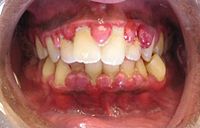
Photo from wikipedia
Dysfunction of human periodontal ligament fibroblasts (PDLFs) contributes to increased prevalence and severity of periodontitis in diabetes. Hyperglycemia induces multiple pathways of metabolic dysfunction: mitochondrial dysfunction, hexosamine and protein kinase… Click to show full abstract
Dysfunction of human periodontal ligament fibroblasts (PDLFs) contributes to increased prevalence and severity of periodontitis in diabetes. Hyperglycemia induces multiple pathways of metabolic dysfunction: mitochondrial dysfunction, hexosamine and protein kinase C pathway activation and increased formation of methylglyoxal (MG) in human periodontal ligament fibroblasts in vitro. We recently showed that increased glucose metabolism driving metabolic dysfunction in hyperglycemia is produced by glucose-induced stabilization of hexokinase-2 (HK2) to proteolysis, increasing HK2 activity. In this study we investigated correction of this by combination of resveratrol and hesperetin (tRES-HESP) which induces expression of glyoxalase 1 (Glo1) and protects against increased MG. Human PDLFs were incubated in primary culture with 8 mM or 25 mM glucose for 3 days with and without 10 µM tRES-HESP. Glucose consumption and flux of MG formation was measured by enzymatic assay. Activity of glyoxalase 1 (Glo1) was measured by spectrophotometric assay. HK2 protein was determined by Western blotting. The flux of glucose consumption in high glucose concentration cultures of PDLFs was increased, compared to low glucose concentration control (10,658 ± 1,141 vs. 5,923 ± 706 nmol/106 cells/day, n = 3; +80%, P Disclosure N. Rabbani: None. A.A. Ashour: None. M. Xue: None. P. Thornalley: None.
Journal Title: Diabetes
Year Published: 2019
Link to full text (if available)
Share on Social Media: Sign Up to like & get
recommendations!